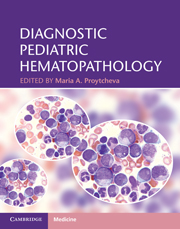Book contents
- Frontmatter
- Contents
- List of contributors
- Acknowledgements
- Introduction
- Section 1 General and non-neoplastic hematopathology
- Section 2 Neoplastic hematopathology
- 10 Chromosome abnormalities of hematologic malignancies
- 11 Expression profiling in pediatric acute leukemias
- 12 Myeloproliferative neoplasms
- 13 Myelodysplastic/myeloproliferative neoplasms
- 14 Myelodysplastic syndromes and therapy-related myeloid neoplasms
- 15 Acute myeloid leukemia and related precursor neoplasms
- 16 Hematologic abnormalities in individuals with Down syndrome
- 17 Precursor lymphoid neoplasms
- 18 Advances in prognostication and treatment of pediatric acute leukemia
- 19 The effect of chemotherapy, detection of minimal residual disease, and hematopoietic stem cell transplantation
- 20 Pediatric small blue cell tumors metastatic to the bone marrow
- 21 Pediatric mature B-cell non-Hodgkin lymphomas
- 22 Pediatric mature T-cell and NK-cell non-Hodgkin lymphomas
- 23 Hodgkin lymphoma
- 24 Immunodeficiency-associated lymphoproliferative disorders
- 25 Histiocytic proliferations in childhood
- 26 Cutaneous and subcutaneous lymphomas in children
- Index
- References
23 - Hodgkin lymphoma
from Section 2 - Neoplastic hematopathology
Published online by Cambridge University Press: 03 May 2011
- Frontmatter
- Contents
- List of contributors
- Acknowledgements
- Introduction
- Section 1 General and non-neoplastic hematopathology
- Section 2 Neoplastic hematopathology
- 10 Chromosome abnormalities of hematologic malignancies
- 11 Expression profiling in pediatric acute leukemias
- 12 Myeloproliferative neoplasms
- 13 Myelodysplastic/myeloproliferative neoplasms
- 14 Myelodysplastic syndromes and therapy-related myeloid neoplasms
- 15 Acute myeloid leukemia and related precursor neoplasms
- 16 Hematologic abnormalities in individuals with Down syndrome
- 17 Precursor lymphoid neoplasms
- 18 Advances in prognostication and treatment of pediatric acute leukemia
- 19 The effect of chemotherapy, detection of minimal residual disease, and hematopoietic stem cell transplantation
- 20 Pediatric small blue cell tumors metastatic to the bone marrow
- 21 Pediatric mature B-cell non-Hodgkin lymphomas
- 22 Pediatric mature T-cell and NK-cell non-Hodgkin lymphomas
- 23 Hodgkin lymphoma
- 24 Immunodeficiency-associated lymphoproliferative disorders
- 25 Histiocytic proliferations in childhood
- 26 Cutaneous and subcutaneous lymphomas in children
- Index
- References
Summary
Definition
Hodgkin lymphomas (HLs) encompass at least two morphologically, biologically, and clinically distinct subtypes of germinal center-derived B-lineage lymphoma [1]. Morphologically, these lymphomas are characterized by a small number of large atypical malignant cells (Hodgkin, Reed–Sternberg, and lymphocytic and histiocytic, or L&H, cells) set in the background of benign inflammatory elements, with or without associated fibrosis, that make up the bulk of the tumoral tissue. The neoplastic cells are typically surrounded by rosettes of T-lymphocytes. In the nodular lymphocyte-predominant type of HL (NLPHL), the neoplastic cells exhibit overt B-lineage differentiation. In the classical type of HL (cHL), these cells exhibit an aberrant differentiation program, and have a characteristic, CD15-positive, CD30-positive, CD45 (leukocyte common antigen)-negative immunophenotype. Classical HL is further subclassified according to the growth pattern and cellular milieu, into the lymphocyte-rich (LR), nodular sclerosis (NS), mixed cellularity (MC), and lymphocyte-depleted (LD) subtypes.
Epidemiology
HL has a bimodal age distribution throughout the world, with a peak of incidence at 15–34 years and a second peak after the age of 60 years [2]. A significant proportion of cases occurs in the pediatric age group, the majority of which present in adolescents, with only a minority of cases seen in patients under the age of 10 years [3, 4]. In the United States and Western European countries, the incidence of HL is <1 per million in children under 10 years of age, and approximately 29 per million in adolescents (10–19 years of age) [3, 4].
- Type
- Chapter
- Information
- Diagnostic Pediatric Hematopathology , pp. 465 - 483Publisher: Cambridge University PressPrint publication year: 2011



